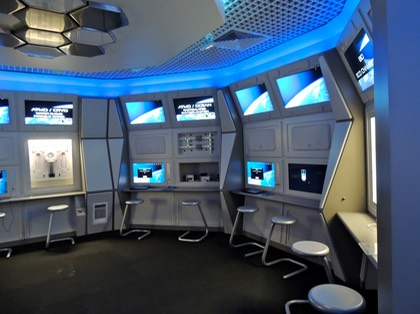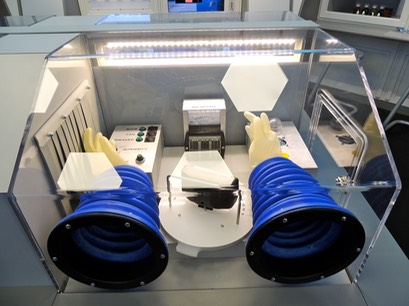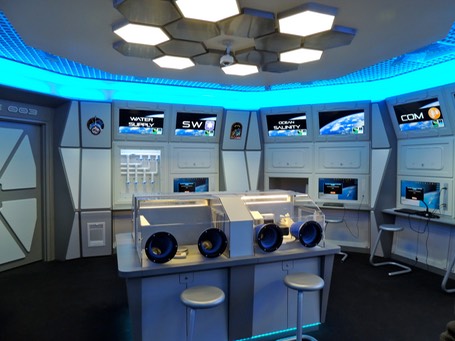Published in the La Vernia News on March 19, 2015

It's a Blast!
Challenger Learning Center offers an out-of- this world experience
There are a total of 44 Challenger Learning Centers throughout the United States, Canada, the United Kingdom, and South Korea. But the center at the Scobee Planetarium on the campus of San Antonio College is on the cutting edge in advanced technology. The amazing programs that they offer here are geared to engage young minds in all areas of science, technology, engineering, and math (STEM).
Everyday Journeys
Harry and Linda Kaye Perez
The core of each Challenger Learning Center is an interactive computerized simulator with a Mission Control room patterned after the NASA Johnson Space Center and an orbiting space station ready for exploration. These hands-on facilities give students the chance to participate in dynamic simulated space missions and cultivate the skills needed for future success through teamwork and problem solving. It is befitting that this Learning Center was relocated after 10 years at the Brooks City Base to the newly renovated Scobee Planetarium. According to Bob Kelley, Planetarium Coordinator, “This is where it was meant to be.”
This very special program targets 5th to 8th grade students to participate in a simulated space mission. School districts have to submit a request for a specific date. The cost to the district is $500.00 (approximately $15 per student) and the Learning Center can schedule up to eight “missions” each week led by a seasoned Flight Director. Each mission starts with a group of 32 students, chosen by their teachers, who also have to undergo training prior to the event to prepare their students. The 2½ hour mission begins with a NASA-style briefing; half of students proceed to Mission Control, dawn official looking badges, and are assigned to one of the station such Communications, Weather, Energy, Oceanography, and Cryogenics, just to name a few. With a push of a button, computers rise from the center of their workstations and their journey begins.
The other students slip into their space vests, enter into the transporter for their trip up to the space station. The transporter simulates the sights, sounds, and all the sensations of a blastoff from earth, the quietness of space, and then the distinctive thud of docking with the orbiting station. After docking, the crew enters the space station via an airlock and then a decontamination room. Once inside the space station, their “work” begins. Working together with Mission Control, there are many tasks that have to be performed and experiments that have to be accomplished.

Half way into the mission, there is an emergency - lights start flashing, emergency signs flash on all the computers, and sirens go off. “We must get the crew back from the space station.” Back into the transporter, the Space Station Crew prepares for their return trip back to earth. Arriving at Mission Control, the emergency is resolved. This is the perfect time to switch crews - the Mission Control crew goes back up to the space station and the crew that just returned takes over Mission Control.
One of the major tasks for both crews is the building of a satellite that must be launched. Using remote cameras, Mission Control guides the Space Station Crew through a series of steps to assemble the satellite. Teamwork is essential to have a successful launch of the satellite and therefore, a successful mission, just like the astronauts.
As we were mesmerized with the idea of space travel, Bob Kelley mentioned that at the end of a mission, one of the young participants asked him, “Did we really go into space?” That is how real the experience is, thanks to a well-trained staff, and all the Disney-type special effects. This is more than a game - more than a day off from school. This program is inspiring curiosity in the minds of our future explorers.

Because there has been so much excitement about this Challenger Learning Center, there is also a plan to offer this experience to the general public. The first foray into this plan is a Valentine’s Day Wine and Cheese Couples Mission that was offered on the center’s website in late January and sold out in three days. Mr. Kelley told us that there are more special events planned for the future, possibly a Mother’s Day and Father’s Day Mission, and definitely a Halloween Mission, where participants are invited to come as their favorite alien. There will be a charge for these special programs - but the experience will be priceless. We are already in line!
The Challenger Learning Center is located on the San Antonio Collage Campus, 1300 San Pedro Avenue, (210) 486-0100, Website: www.alamo.edu/sac/planetarium/
Stay Current
Best way to keep current with activities & programs: Scobee Planetarium’s Facebook page
General Information on the Challenger Centers worldwide: www.challenger.org
10 9 8 7 6 . . .